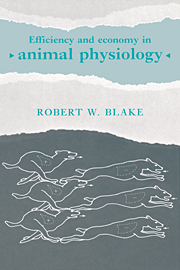Book contents
- Frontmatter
- Contents
- List of contributors
- Preface
- 1 Efficiency, effectiveness, perfection, optimization: their use in understanding vertebrate evolution
- 2 On the efficiency of energy transformations in cells and animals
- 3 Adapting skeletal muscle to be efficient
- 4 Efficiency and other criteria for evaluating the quality of structural biomaterials
- 5 Efficiency and optimization in the design of skeletal support systems
- 6 Efficiency in aquatic locomotion: limitations from single cells to animals
- 7 The concepts of efficiency and economy in land locomotion
- 8 Respiration in air breathing vertebrates: optimization and efficiency in design and function
- 9 Cardiac energetics and the design of vertebrate arterial systems
- 10 An evolutionary perspective on the concept of efficiency: how does function evolve?
- Index
5 - Efficiency and optimization in the design of skeletal support systems
Published online by Cambridge University Press: 03 October 2009
- Frontmatter
- Contents
- List of contributors
- Preface
- 1 Efficiency, effectiveness, perfection, optimization: their use in understanding vertebrate evolution
- 2 On the efficiency of energy transformations in cells and animals
- 3 Adapting skeletal muscle to be efficient
- 4 Efficiency and other criteria for evaluating the quality of structural biomaterials
- 5 Efficiency and optimization in the design of skeletal support systems
- 6 Efficiency in aquatic locomotion: limitations from single cells to animals
- 7 The concepts of efficiency and economy in land locomotion
- 8 Respiration in air breathing vertebrates: optimization and efficiency in design and function
- 9 Cardiac energetics and the design of vertebrate arterial systems
- 10 An evolutionary perspective on the concept of efficiency: how does function evolve?
- Index
Summary
ABSTRACT
Optimization approaches, if properly applied and interpreted, can be of value in identifying and evaluating critical features of the design of skeletal support systems. However, the use of ‘efficiency’ (defined as strength per unit mass) to characterize the quality of skeletal design is often misleading or unwarranted because of (i) its lack of correspondence to thermodynamic efficiency and (ii) mechanical properties other than strength (e.g. toughness, stiffness, strain energy recovery) are often important in the design of skeletons. Instead, less ambiguous terms, such as specific strength or specific stiffness, should be used. In this Chapter, we review cases in which design to maximize specific strength provides a good explanation of certain features of bone shape and organization in the limb. However, when the biological roles of bone elements differ significantly, evaluation of the material and/or structural properties of bone by any one criterion, such as failure strength, is insufficient. In this case, optimization of competing functional properties must be considered. At a structural level, optimization of bone shape for strength versus loading predictability appears likely in the long bones of mammals. We also show that a trade off exists in the design of tendon for effective elastic energy recovery in large kangaroos versus acceleration and strength in mush smaller kangaroo rats. More generally, thick tendons appear to reflect the importance of stiffness for motor control of muscle length change and motion at a joint. Though optimality approaches help to evaluate the interaction of such constraints on design, it should be recognized that such approaches largely ignore historical constraints on form and function.
- Type
- Chapter
- Information
- Efficiency and Economy in Animal Physiology , pp. 65 - 82Publisher: Cambridge University PressPrint publication year: 1992
- 1
- Cited by



